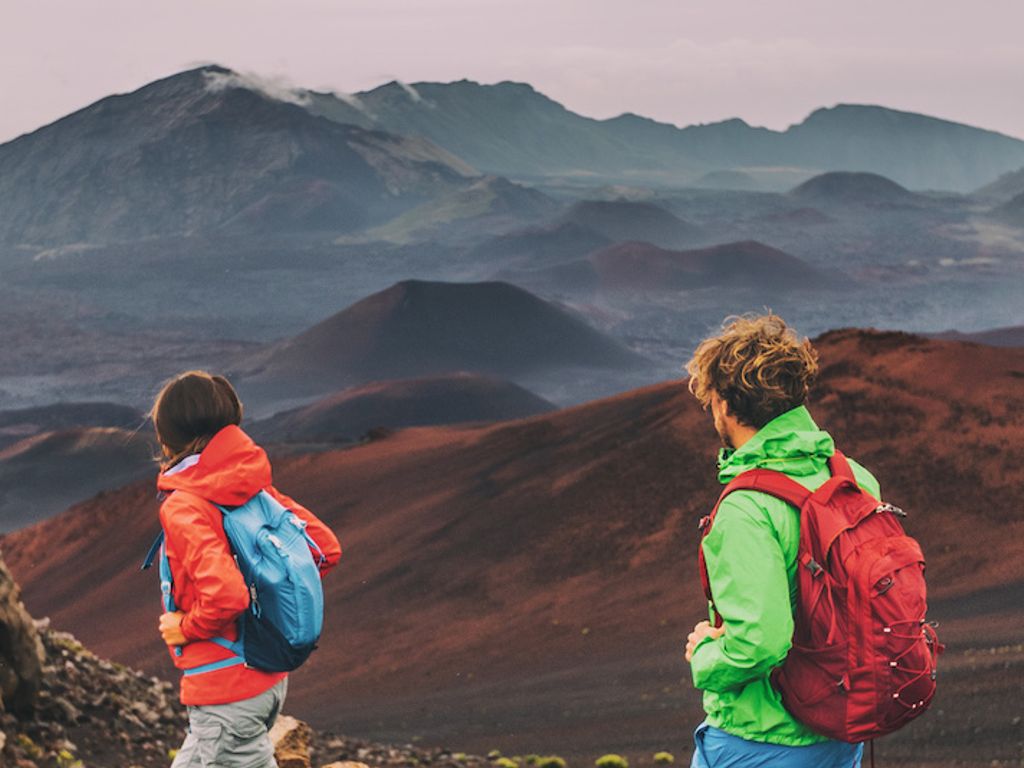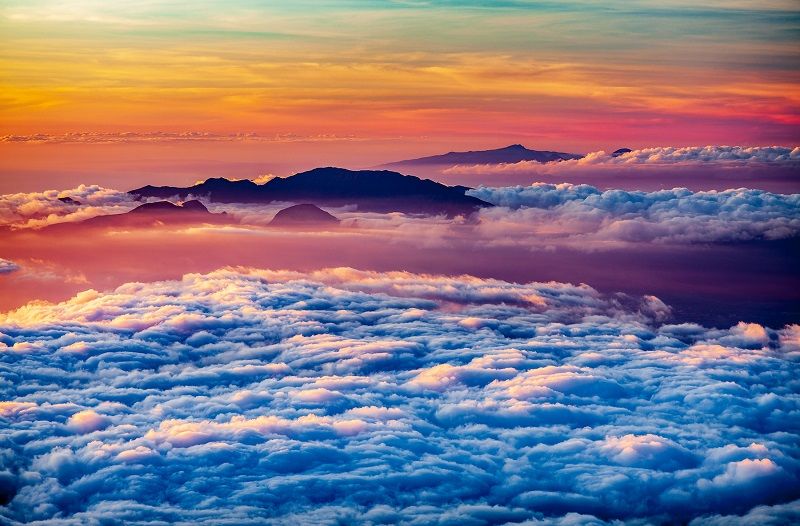
Visiting Haleakala - A Guide to Exploring Maui’s Famous Volcano
July 18, 2019
Haleakala, meaning “house of the sun”, is a massive shield volcano that rises 10,023 ft into the clouds above Maui. To say it is located on the island of Maui is an understatement, as it makes up more than 75% of Maui’s total landmass. Protected in as a National Park, Haleakala is one of the most popular visitor attractions. Its other-worldly volcanic landscape and incredible views are truly a unique sight to see. On clear days, you can spot other Hawaiian Islands in the archipelago from the summit, rising out of the vast Pacific. Whether you want to experience the sunrise from the summit, go for a hike, or simply enjoy a gorgeous drive to the top, read on for more information on visiting Haleakala.
History
In Hawaiian legend, the crater at the summit of Haleakala is believed to be the home of the demigod Maui’s grandmother. The story is that she helped him capture the sun so that he could slow its journey across the sky and make the day last longer. To this day, Haleakala is considered a sacred place by Native Hawaiians and to be wao akua “the wilderness of the gods”.
Lava flow from Haleakala’s last eruption can be seen at La Perouse Bay on the coast. Some sources put the date of the last eruption at 1790, however, the USGS states that it was likely earlier than that, between 1480 and 1600. It is still considered to be an active volcano and has erupted several times in the last 500 years. It is currently listed as having a “normal” or green threat level by the USGS. Haleakala was established as a National Park in 1961.

Getting There
The entrance to the National Park at the summit of Haleakala is about a 2-hour drive from Lahaina. The most difficult, and scenic part of the trip is the final stretch between Kula and the summit on Haleakala Highway, which has many hairpin turns. A regular two-wheel drive vehicle can make the drive. Entrance fees are $25 per vehicle and are good for three days. Payment is by credit card.
To Take a Tour... Or Not?
Some visitors opt to take a tour to the summit of Haleakala rather than drive themselves. There are many companies to choose from. One of the major benefits of taking a tour is if you are wanting to go to the summit to see the sunrise, the tour company will arrange your permit for you, and you won’t have to drive in the dark early in the morning. Many tours include breakfast, too.
The downsides of taking a tour are less autonomy and the ability to explore and play things by ear. If you have a single objective in mind and don’t like driving, a tour would likely be your best option. If you do like to drive and want more flexibility to stop where you please, renting a car and driving yourself will be the most enjoyable for you.
What to See and Do
There are many ways to experience Haleakala, and plenty of great places to stop along the way to the summit, or on the way back as you drive through upcountry Maui. For more information, see our blog post Explore Upcountry Maui. Here are a few points of interest for what to see while visiting Haleakala. Before you begin, stop off at the Park Headquarters Visitors Center, open 8 am - 4 pm, or the one at the summit, open sunrise - noon for maps and information. Both have restrooms open 24 hours a day.
The Summit
Take a deep breath of crisp air. You are at over 10,023 ft elevation, above cloud level. Watch fluffy clouds roll in over the dramatic landscape and dance around the crater rim. Look out over the Pacific Ocean to views of the Big Island’s largest volcano - Mauna Kea on a clear day. Up here, it feels like you’re on top of the world.

Watch the Sunrise or Sunset
Sunrise and sunset from the top of Haleakala is a fantastic sight when the weather is cooperating. Watch as the clouds all around you turn cotton candy hues of orange, pink, and purple. Due to popularity, you need to obtain a permit to view the sunrise on Haleakala. You must apply for a permit online or call 1-877-444-6777. Reservations can be made up to 60 days before the date of your intended visit. It’s best to book ahead of time. If you are part of a tour, your tour operator should take care of this for you. No permit is currently required to watch the sunset from the summit.
The issue with purchasing a permit for the sunrise is that you never know what the weather is going to be doing, and your permit cannot be exchanged or refunded by the park due to bad weather for a different day. Some people prefer to visit the summit a little later in the morning so they can fully appreciate the views on the way up through beautiful upcountry Maui. Generally, mornings are more likely to be clear than afternoons, when views can be inhibited by cloud cover.
Hiking
For hiking enthusiasts, Haleakala National Park offers some incredible hiking. Trails range from 10 minutes to all day hikes. Perhaps the most stunning hike is the Sliding Sands Trail which takes you down to the crater floor and past spectacular features like ‘Pele’s Paint Pot’ - with its technicolored lava. The full hike is 11 miles round trip, and not for the novice hiker. The initial descent to the crater floor is over 2400 ft. and 3.8 miles. Check the park website section on hiking for more information on where to park and different hikes.
Rare Species
Keep an eye out for interesting flora and fauna. Haleakala is home to rare animal and plant species, like the Nene, (Hawaiian goose), and the `Ua'u (Hawaiian Petrel). Haleakala silverswords, which look like they are straight out of a Dr. Seuss story are an endemic plant found nowhere else on earth. They flower once in their lifetime and then die after flowering. They can live from 3 to 90 years old.

What to Bring and Weather
Haleakala is very remote, with stores and gas stations a good 30-minute drive away. The last town to get gas before the summit is in Pukalani, or in Kula, which is more expensive. Make sure to bring plenty of water, snacks, and sunscreen as there is no shade. No drones are permitted.
Come prepared for changing weather conditions. During the winter season, October - May, there can be snow at the summit. Before you go, check the USGS website for alerts. It is recommended to bring warm clothing and shoes if you plan to spend some time at the top. Temperatures at the summit are at least 20 °F lower than at sea level and often drop to freezing.
Kipahulu District
Also part of Haleakala National Park, the Kipahulu District is a coastal region on the backside of Haleakala, southwest of Hana. In ancient Hawaii, this area was heavily populated with communities farming and fishing. Today the Kipahulu Living Farm, part of a 501c3 non-profit organization continues traditional wetland taro farming and provides other services and education to the community.
The Kipahulu District offers some excellent hiking, including one of the best waterfall hikes on the island, to Waimoku Falls via the Pīpīwai Trail. The 3.5-mile moderate round trip hike takes you through banyan groves, a bamboo forest, and alongside rivers to a view of the 400 ft. waterfall.
To reach Kipahulu from Lahaina area, it’s about a 2.5-hour drive. The fastest route takes you upcountry through Kula, around the side of Haleakala, and down to the coast to the Pi'ilani Hwy, which becomes the Hana Hwy.
Have you visited Haleakala, or plan to on your next trip to Maui? What’s your favorite way to explore Haleakala National Park? We’d love to hear from you. Drop us a line, and share some photos with us for a chance to be featured on our social media feed @mauiresortrentals on Instagram.